Keke Ying
AI Signal Processing Paradigm for Movable Antenna: From Geometric Optimization to Electromagnetic Reconfigurability
Oct 22, 2025Abstract:As 6G wireless communication systems evolve toward intelligence and high reconfigurability, the limitations of traditional fixed antenna (TFA) has become increasingly prominent, with geometrically movable antenna (GMA) and electromagnetically reconfigurable antenna (ERA) emerging as key technologies to break through this bottleneck. GMA activates spatial degrees of freedom (DoF) by dynamically adjusting antenna positions, ERA regulates radiation characteristics using tunable metamaterials, thereby introducing DoF in the electromagnetic domain. However, the ``geometric-electromagnetic dual reconfiguration" paradigm formed by their integration poses severe challenges of high-dimensional hybrid optimization to signal processing. To address this issue, we integrate the geometric optimization of GMA and the electromagnetic reconfiguration of ERA for the first time, propose a unified modeling framework for movable and reconfigurable antenna (MARA), investigate the channel modeling and spectral efficiency (SE) optimization for GMA, ERA, and MARA. Besides, we systematically review artificial intelligence (AI)-based solutions, focusing on analyzing the advantages of AI over traditional algorithms in high-dimensional non-convex optimization computations. This paper fills the gap in existing literature regarding the lack of a comprehensive review on the AI-driven signal processing paradigm under geometric-electromagnetic dual reconfiguration and provides theoretical support for the design and optimization of 6G wireless systems with high SE and flexibility.
Generative Diffusion Model Driven Massive Random Access in Massive MIMO Systems
May 18, 2025Abstract:Massive random access is an important technology for achieving ultra-massive connectivity in next-generation wireless communication systems. It aims to address key challenges during the initial access phase, including active user detection (AUD), channel estimation (CE), and data detection (DD). This paper examines massive access in massive multiple-input multiple-output (MIMO) systems, where deep learning is used to tackle the challenging AUD, CE, and DD functions. First, we introduce a Transformer-AUD scheme tailored for variable pilot-length access. This approach integrates pilot length information and a spatial correlation module into a Transformer-based detector, enabling a single model to generalize across various pilot lengths and antenna numbers. Next, we propose a generative diffusion model (GDM)-driven iterative CE and DD framework. The GDM employs a score function to capture the posterior distributions of massive MIMO channels and data symbols. Part of the score function is learned from the channel dataset via neural networks, while the remaining score component is derived in a closed form by applying the symbol prior constellation distribution and known transmission model. Utilizing these posterior scores, we design an asynchronous alternating CE and DD framework that employs a predictor-corrector sampling technique to iteratively generate channel estimation and data detection results during the reverse diffusion process. Simulation results demonstrate that our proposed approaches significantly outperform baseline methods with respect to AUD, CE, and DD.
Reconfigurable Massive MIMO: Precoding Design and Channel Estimation in the Electromagnetic Domain
May 05, 2024



Abstract:Reconfigurable massive multiple-input multiple-output (RmMIMO) technology offers increased flexibility for future communication systems by exploiting previously untapped degrees of freedom in the electromagnetic (EM) domain. The representation of the traditional spatial domain channel state information (sCSI) limits the insights into the potential of EM domain channel properties, constraining the base station's (BS) utmost capability for precoding design. This paper leverages the EM domain channel state information (eCSI) for radiation pattern design at the BS. We develop an orthogonal decomposition method based on spherical harmonic functions to decompose the radiation pattern into a linear combination of orthogonal bases. By formulating the radiation pattern design as an optimization problem for the projection coefficients over these bases, we develop a manifold optimization-based method for iterative radiation pattern and digital precoder design. To address the eCSI estimation problem, we capitalize on the inherent structure of the channel. Specifically, we propose a subspace-based scheme to reduce the pilot overhead for wideband sCSI estimation. Given the estimated full-band sCSI, we further employ parameterized methods for angle of arrival estimation. Subsequently, the complete eCSI can be reconstructed after estimating the equivalent channel gain via the least squares method. Simulation results demonstrate that, in comparison to traditional mMIMO systems with fixed antenna radiation patterns, the proposed RmMIMO architecture offers significant throughput gains for multi-user transmission at a low channel estimation overhead.
Near-Space Communications: The Last Piece of 6G Space-Air-Ground-Sea Integrated Network Puzzle
Dec 30, 2023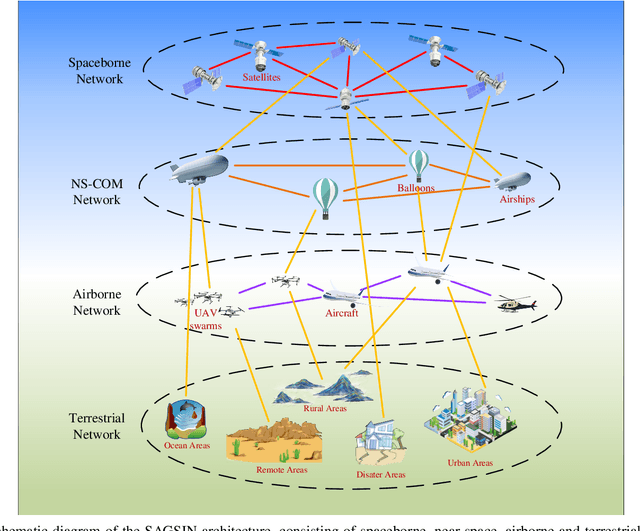
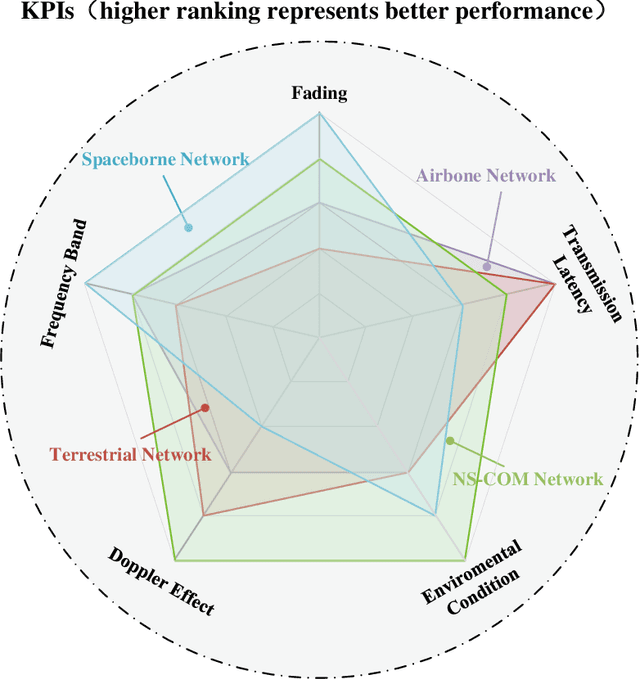
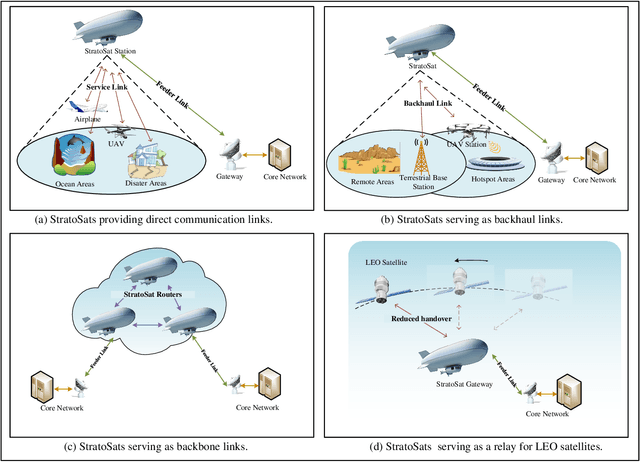
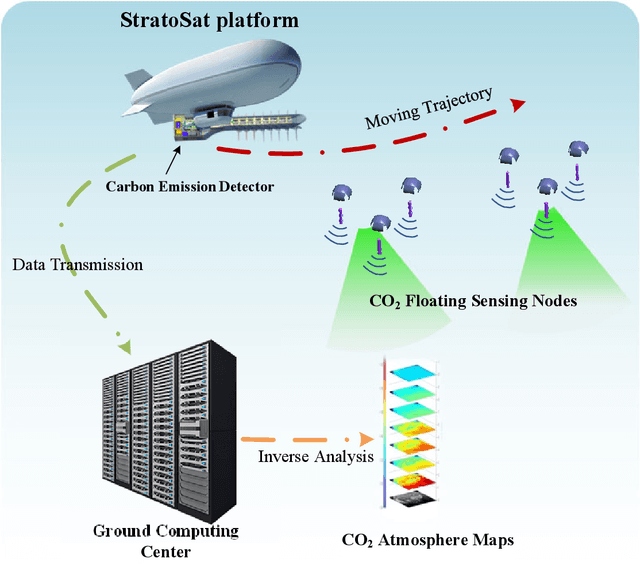
Abstract:This article presents a comprehensive study on the emerging near-space communications (NS-COM) within the context of space-air-ground-sea integrated network (SAGSIN). Specifically, we firstly explore the recent technical developments of NS-COM, followed by the discussions about motivations behind integrating NS-COM into SAGSIN. To further demonstrate the necessity of NS-COM, a comparative analysis between the NS-COM network and other counterparts in SAGSIN is conducted, covering aspects of deployment, coverage and channel characteristics. Afterwards, the technical aspects of NS-COM, including channel modeling, random access, channel estimation, array-based beam management and joint network optimization, are examined in detail. Furthermore, we explore the potential applications of NS-COM, such as structural expansion in SAGSIN communications, remote and urgent communications, weather monitoring and carbon neutrality. Finally, some promising research avenues are identified, including near-space-ground direct links, reconfigurable multiple input multiple output (MIMO) array, federated learning assisted NS-COM, maritime communication and free space optical (FSO) communication. Overall, this paper highlights that the NS-COM plays an indispensable role in the SAGSIN puzzle, providing substantial performance and coverage enhancement to the traditional SAGSIN architecture.
Quasi-Synchronous Random Access for Massive MIMO-Based LEO Satellite Constellations
Apr 10, 2023Abstract:Low earth orbit (LEO) satellite constellation-enabled communication networks are expected to be an important part of many Internet of Things (IoT) deployments due to their unique advantage of providing seamless global coverage. In this paper, we investigate the random access problem in massive multiple-input multiple-output-based LEO satellite systems, where the multi-satellite cooperative processing mechanism is considered. Specifically, at edge satellite nodes, we conceive a training sequence padded multi-carrier system to overcome the issue of imperfect synchronization, where the training sequence is utilized to detect the devices' activity and estimate their channels. Considering the inherent sparsity of terrestrial-satellite links and the sporadic traffic feature of IoT terminals, we utilize the orthogonal approximate message passing-multiple measurement vector algorithm to estimate the delay coefficients and user terminal activity. To further utilize the structure of the receive array, a two-dimensional estimation of signal parameters via rotational invariance technique is performed for enhancing channel estimation. Finally, at the central server node, we propose a majority voting scheme to enhance activity detection by aggregating backhaul information from multiple satellites. Moreover, multi-satellite cooperative linear data detection and multi-satellite cooperative Bayesian dequantization data detection are proposed to cope with perfect and quantized backhaul, respectively. Simulation results verify the effectiveness of our proposed schemes in terms of channel estimation, activity detection, and data detection for quasi-synchronous random access in satellite systems.
Reconfigurable Massive MIMO: Harnessing the Power of the Electromagnetic Domain for Enhanced Information Transfer
Feb 22, 2023


Abstract:The capacity of commercial massive multiple-input multiple-output (mMIMO) systems is constrained by the limited array aperture at the base station, and cannot meet the ever-increasing traffic demands of wireless networks. Given the array aperture, holographic MIMO with infinitesimal antenna spacing can maximize the capacity, but is physically unrealizable. As a promising alternative, reconfigurable mMIMO is proposed to harness the unexploited power of the electromagnetic (EM) domain for enhanced information transfer. Specifically, the reconfigurable pixel antenna technology provides each antenna with an adjustable EM radiation (EMR) pattern, introducing extra degrees of freedom for information transfer in the EM domain. In this article, we present the concept and benefits of availing the EMR domain for mMIMO transmission. Moreover, we propose a viable architecture for reconfigurable mMIMO systems, and the associated system model and downlink precoding are also discussed. In particular, a three-level precoding scheme is proposed, and simulation results verify its considerable spectral and energy efficiency advantages compared to traditional mMIMO systems. Finally, we further discuss the challenges, insights, and prospects of deploying reconfigurable mMIMO, along with the associated hardware, algorithms, and fundamental theory.
Active Terminal Identification, Channel Estimation, and Signal Detection for Grant-Free NOMA-OTFS in LEO Satellite Internet-of-Things
Jan 06, 2022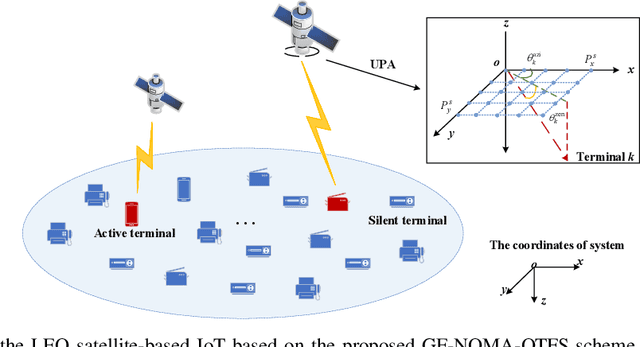
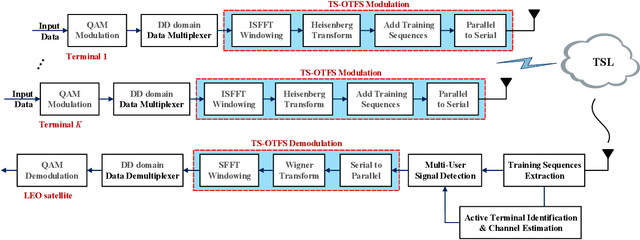

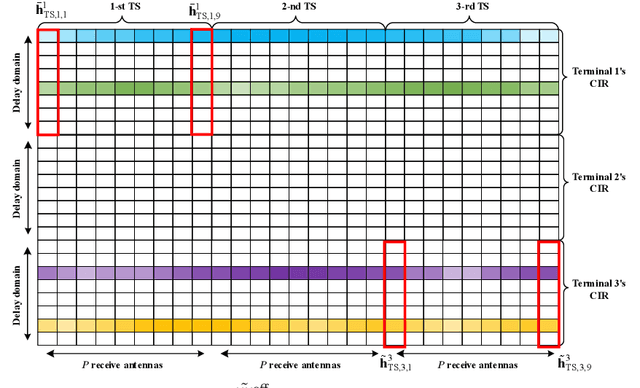
Abstract:This paper investigates the massive connectivity of low Earth orbit (LEO) satellite-based Internet-of-Things (IoT) for seamless global coverage. We propose to integrate the grant-free non-orthogonal multiple access (GF-NOMA) paradigm with the emerging orthogonal time frequency space (OTFS) modulation to accommodate the massive IoT access, and mitigate the long round-trip latency and severe Doppler effect of terrestrial-satellite links (TSLs). On this basis, we put forward a two-stage successive active terminal identification (ATI) and channel estimation (CE) scheme as well as a low-complexity multi-user signal detection (SD) method. Specifically, at the first stage, the proposed training sequence aided OTFS (TS-OTFS) data frame structure facilitates the joint ATI and coarse CE, whereby both the traffic sparsity of terrestrial IoT terminals and the sparse channel impulse response are leveraged for enhanced performance. Moreover, based on the single Doppler shift property for each TSL and sparsity of delay-Doppler domain channel, we develop a parametric approach to further refine the CE performance. Finally, a least square based parallel time domain SD method is developed to detect the OTFS signals with relatively low complexity. Simulation results demonstrate the superiority of the proposed methods over the state-of-the-art solutions in terms of ATI, CE, and SD performance confronted with the long round-trip latency and severe Doppler effect.
 Add to Chrome
Add to Chrome Add to Firefox
Add to Firefox Add to Edge
Add to Edge